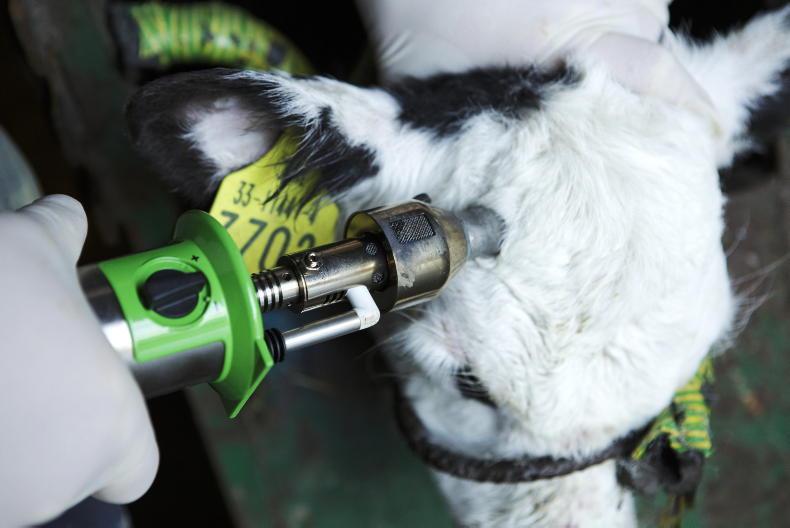Dehorning calves is a task that should be carried out as early as possible to reduce the stress on young animals. With the 2024 calf crop hitting the ground, outlined are a few tips for dehorning.
1. Using a dehorning paste
Caustic pastes can be used to dehorn calves within the first week of life. Clip the hair around the horn buds to give greater exposure and contact area, then spread the paste on the bud.
A key part to the success of dehorning with caustic paste is locking calves off cows for a good six-hour period after application.
This stops the cow licking the paste off the calf’s head, giving plenty of time for the paste to burn into the horn bud.
2. Make use of a dehorning crate
When disbudding calves using a handheld dehorning iron or a Barnes dehorner, make sure calves are securely restrained in a crate before carrying out the procedure. This stops the calf from moving its head, allowing greater accuracy when placing the dehorner on the bud.
3. Always use an anesthetic
Dehorning is a stressful for calves. Always use an anesthetic to freeze the nerves around the horn first.
The correct injection site is a grooved channel running between the calf’s eye and horn bud. Use anesthetic on both sides of the head.
Allow five to 10 minutes for the anesthetic to work. Batch calves in small groups of five or six, then anesthetise them one after the other.
By the time the final calf in the group gets the anesthetic, the first calf should have had adequate time for the nerves to be frozen and ready to dehorn.
4. Using the dehorning iron
With the calf’s head securely restrained, clip the hair around the horn. Make sure the dehorning iron is piping hot. To test the temperature, the iron should burn a concentric ring on a piece of timber.
Hold the calf’s ear out of the way, then place the dehorning iron on the bud. Rotate the iron clockwise and anti-clockwise for five seconds, then remove the bud.
5. Cauterize and use an antiseptic spray
Once the horn bud is removed, cauterize the open bud with a hot iron to stop any bleeding. Finish the task with an antiseptic spray and release the calf back to its dam as soon as possible.
Read more
Farmers urged to 'shop around' for best price for cattle
Brief weather window for slurry and fertiliser
Dehorning calves is a task that should be carried out as early as possible to reduce the stress on young animals. With the 2024 calf crop hitting the ground, outlined are a few tips for dehorning.
1. Using a dehorning paste
Caustic pastes can be used to dehorn calves within the first week of life. Clip the hair around the horn buds to give greater exposure and contact area, then spread the paste on the bud.
A key part to the success of dehorning with caustic paste is locking calves off cows for a good six-hour period after application.
This stops the cow licking the paste off the calf’s head, giving plenty of time for the paste to burn into the horn bud.
2. Make use of a dehorning crate
When disbudding calves using a handheld dehorning iron or a Barnes dehorner, make sure calves are securely restrained in a crate before carrying out the procedure. This stops the calf from moving its head, allowing greater accuracy when placing the dehorner on the bud.
3. Always use an anesthetic
Dehorning is a stressful for calves. Always use an anesthetic to freeze the nerves around the horn first.
The correct injection site is a grooved channel running between the calf’s eye and horn bud. Use anesthetic on both sides of the head.
Allow five to 10 minutes for the anesthetic to work. Batch calves in small groups of five or six, then anesthetise them one after the other.
By the time the final calf in the group gets the anesthetic, the first calf should have had adequate time for the nerves to be frozen and ready to dehorn.
4. Using the dehorning iron
With the calf’s head securely restrained, clip the hair around the horn. Make sure the dehorning iron is piping hot. To test the temperature, the iron should burn a concentric ring on a piece of timber.
Hold the calf’s ear out of the way, then place the dehorning iron on the bud. Rotate the iron clockwise and anti-clockwise for five seconds, then remove the bud.
5. Cauterize and use an antiseptic spray
Once the horn bud is removed, cauterize the open bud with a hot iron to stop any bleeding. Finish the task with an antiseptic spray and release the calf back to its dam as soon as possible.
Read more
Farmers urged to 'shop around' for best price for cattle
Brief weather window for slurry and fertiliser






 This is a subscriber-only article
This is a subscriber-only article










SHARING OPTIONS: